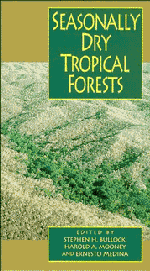Book contents
- Frontmatter
- Contents
- List of contributors
- Acknowledgements
- 1 Introduction
- 2 Dry forests of Central America and the Caribbean
- 3 Overview of the Brazilian caatinga
- 4 Savannas, woodlands and dry forests in Africa
- 5 Dry forest ecosystems of Thailand
- 6 The Cenozoic record of tropical dry forest in northern Latin America and the southern United States
- 7 Diversity and floristic composition of neotropical dry forests
- 8 Vertebrate diversity, ecology and conservation in neotropical dry forests
- 9 Diversity of life forms of higher plants in neotropical dry forests
- 10 Drought responses of neotropical dry forest trees
- 11 Plant reproduction in neotropical dry forests
- 12 Plant–herbivore interactions in Mesoamerican tropical dry forests
- 13 Biomass distribution and primary productivity of tropical dry forests
- 14 Nutrient cycling in tropical deciduous forests
- 15 Biology of the belowground system of tropical dry forests
- 16 Nitrogen trace gas emissions in a tropical dry forest ecosystem
- 17 Conversion of tropical dry forest to pasture and agriculture
- 18 Ethnobotany of the Mexican tropical dry forests
- Index
2 - Dry forests of Central America and the Caribbean
Published online by Cambridge University Press: 07 September 2010
- Frontmatter
- Contents
- List of contributors
- Acknowledgements
- 1 Introduction
- 2 Dry forests of Central America and the Caribbean
- 3 Overview of the Brazilian caatinga
- 4 Savannas, woodlands and dry forests in Africa
- 5 Dry forest ecosystems of Thailand
- 6 The Cenozoic record of tropical dry forest in northern Latin America and the southern United States
- 7 Diversity and floristic composition of neotropical dry forests
- 8 Vertebrate diversity, ecology and conservation in neotropical dry forests
- 9 Diversity of life forms of higher plants in neotropical dry forests
- 10 Drought responses of neotropical dry forest trees
- 11 Plant reproduction in neotropical dry forests
- 12 Plant–herbivore interactions in Mesoamerican tropical dry forests
- 13 Biomass distribution and primary productivity of tropical dry forests
- 14 Nutrient cycling in tropical deciduous forests
- 15 Biology of the belowground system of tropical dry forests
- 16 Nitrogen trace gas emissions in a tropical dry forest ecosystem
- 17 Conversion of tropical dry forest to pasture and agriculture
- 18 Ethnobotany of the Mexican tropical dry forests
- Index
Summary
Introduction
Holdridge (1947, 1967) developed a bioclimatic classification system by which the world's terrestrial biota may be categorized into approximately 120 life zones, each distinguished by climatic parameters that coincide with particular vegetational characteristics. Approximately 68 life zones are in the tropics and subtropics, of which 30 are dominated by forest of various types. Lugo, Schmidt & Brown (1981) estimated that 28 tropical and subtropical forested life zones are represented in Central America and the Caribbean, and 13 are found on the islands of the Caribbean. Despite this diversity, approximately half of the vegetation of Central America and the Caribbean is within the dry forest life zone (sensu Holdridge, 1967).
Dry forests are not infrequently referred to as deciduous forests, but the degree of deciduousness varies greatly (see below). Not all dry forests are conspicuously deciduous, and not all deciduous forests are dry forest. By Holdridge's criteria, tropical and subtropical dry forests are found in frost-free areas where mean annual biotemperature (a special calculation that reduces the effects of extreme temperatures) is above 17 °C, annual rainfall ranges from 250 to 2000 mm, and the ratio of potential evapotranspiration to precipitation is greater than one, to a maximum value of two. By these criteria, 49% (8.2 × 105 km2) of the vegetation of Central America and the Caribbean is considered dry forest (Brown & Lugo, 1980). Africa has the most dry forest (16.5 × 106 km2; 73% of the continent's vegetation); worldwide, about 42% of all intratropical vegetation is dry forest. Global patterns in dry forest distribution and overall ecological characteristics relative to wetter tropical and subtropical forest ecosystems were reviewed by Murphy & Lugo (1986a).
- Type
- Chapter
- Information
- Seasonally Dry Tropical Forests , pp. 9 - 34Publisher: Cambridge University PressPrint publication year: 1995
- 113
- Cited by



